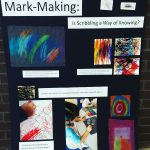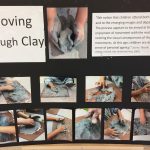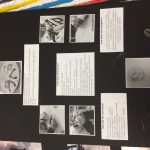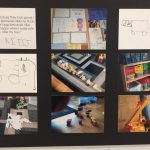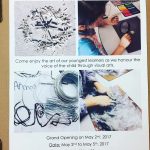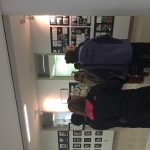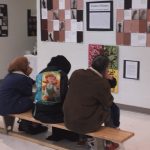Our project was inspired by Articles 12, 13 and 29 of the UN Convention on the Rights of the Child, which outline the child’s rights of expression. We worked collaboratively as educators to build capacity in the visual arts and to share our passion and learning with parents and the community. Through our project, we supported educators in developing knowledge and skills with a range of high-quality art materials to support student expression through the visual arts. We used research and pedagogical documentation to deepen our understanding of children’s relationships with visual mediums and how children use materials to communicate their developing sense of self. We also analyzed children’s artwork to better understand the lives of our children and inequities they encounter (poverty, environmental hazards, shadeism, displacement). As a team, we planned and supported art projects highlighting children’s sense of identity, exposure to inequities and their resiliency, and senses of joy and wonderment. Finally, we consolidated our learning through a school-wide art exhibition to further provide our children with a platform to be viewed as capable creators of culture and global citizens.
Team Members
Niki Singh
Toronto District School Board
Camille Bayliss
Toronto District School Board
Lindsay Keith
Toronto District School Board
Shauna Husbands
Toronto District School Board
Professional Learning Goals
As educators at an all-kindergarten school that focuses on inquiry through an emergent curriculum approach, we:
- developed a proficiency with a range of visual art mediums to use as tools to foster expression and communication, so that we may empower our youngest learners
- informed our use of pedagogical documentation as a means of teacher research and as a way of making children’s thinking visible
- curated an exhibition for our school and greater community of student artwork that was selected through our new understandings of making children’s thinking visible
- worked to honour the diverse languages, backgrounds and experiences of our children and families through the common language of art
- helped to facilitate an equitable school environment through inclusive art pedagogy
Activities and Resources
We began with a school-wide review of current materials and practices to inform our programming. This helped us plan and lead a series of interactive workshops for teachers and early childhood educators to build school-wide capacity with the visual arts. Each team member contributed research from books or articles that added to our understanding of children’s relationship with materials. The four workshops focused on:
- setting up a studio: creating a classroom culture that supports creative expression
- 2D mark-making: proficiency with pastels, charcoal, graphite
- 3D sculptures: creating with wire and clay
- art and the natural world: deepening the connection between art and outdoor learning
In addition to creating our own pedagogical documentation to share with the school as a way of presenting our research from a range of resources, we also held documentation study sessions for the educators at our school to co-create work and make children’s thinking visible.
We developed parent-supported photography and film projects that helped illuminate home-life and family relationships to us as educators and created authentic connections between home and school.
Our final endeavour was an art exhibition for our school and greater community promoting the kindergarten child as a capable creator of culture and as a global citizen.
Unexpected Challenges
We found that the majority of our release time sessions were spent planning our educator art workshops. Subsequently, the majority of the work on research, documentation and planning the art exhibition was completed at lunch time and after school.
Enhancing Student Learning and Development
Overall, we believe that our project:
- helped build capacity with the visual arts in the greater school environment, which had the potential to benefit every student
- empowers our youngest learners to see themselves as competent and capable artists
- contributes to the development of the whole child, including emotional and mental wellness
Through our teacher art workshops, we:
- advocated on the behalf on the child for the importance of having opportunities to communicate through the languages of art
- provided teachers with explicit teaching strategies that meet diverse learning needs of students
- provided students with a range of high-quality art materials
Our pedagogical documentation:
- made children’s thinking visible
- acted as a means of reflection for students and teachers to aid programming
- communicated our teacher research to inform teaching practices that benefit student learning
The whole-school art exhibition:
- demonstrated the cognitive and expressive capabilities of kindergarten children
- promoted the idea of children as artists and active citizens
Sharing
We were able to share aspects of our learning throughout the duration of our project. Through our interactive workshops for educators, we shared our understanding of young children’s relationship to materials. The ongoing creation and sharing of pedagogical documentation made our teacher research and work with the children visible to the school community throughout the year. The formation of an “art exhibition” committee allowed us to further discuss the rationale for our project and gain the support of educators within our school community.
Our school-wide art exhibition in our atrium helped us share our project with a greater range of people who are interested in supporting the growth of young children. They included parents, children, teachers and administration from our neighbouring school, as well as our school trustee and superintendent. We shared our project with the Ontario Reggio Association, TDSB learning coaches and the MA program at JICS/OISE and their promotion of our exhibit helped us reach a larger group of educators.
We continue to honour our children’s voices by sharing their artwork from the exhibit on our Instagram account on a daily basis (fmela.tdsb).
Project Evaluation
We believe that our project was successful. The creation of detailed project tasks during the TLC application process allowed us to work toward completing focused goals. We achieved our goals through:
- the creation of a school-wide facilitation of art as a mode of student expression
- evidence of the use of materials and methodologies by children to express and communicate
- educator and student participation at our school-wide art exhibition. This was indicative of: teacher and ECE comfort with introducing and sustaining learning through the visual arts, student exploration with a range of high-quality art materials, and student capabilities with visual art mediums to express themselves and communicate their thinking.
- the creation and sharing of pedagogical documentation as a means of communicating our research, as well as a tool to make children’s thinking visible
Our project was comprised of three main components: educator workshops, pedagogical documentation and an art exhibition. In the future, each of these parts could lead to the creation of a new project due to their complexity and the amount of time required to explore them in depth.
Resources Used
Pelo, Ann (2007). The Language of Art: Inquiry-Based Studio Practices in Early Childhood Settings. Redleaf Press.
Gandini, Lella et al. (2005). In the Spirit of the Studio: Learning from the Atelier of Reggio Emilia. Teacher’s College Press.
Goldsworthy, Andy (1990). A Collaboration with Nature. Harry N. Abrams.
Eisner, Elliot W. (2002). The Arts and the Creation of the Mind. Yale University Press.
Sheridan, S.R. (2002). “The Neurological Significance of Children’s Drawing: The Scribble Hypothesis.” Journal of Visual Literacy, vol. 22, no.22, pp 107-128.
Matthews, J. (2003). Drawing and Painting: Children and Visual Representation. Paul Chapman Publishing.
Matthews, J. (1999). The Art of Childhood and Adolescence: The Construction of Meaning. Falmer.
Schultz, P.W. (2002). “Inclusion with Nature: The psychology of human-nature relationships.” Sustainable Development pp 62-67.
Krechevsky, Mara et al. (2013). Visible Learners: Promoting Reggio-Inspired Approaches in All Schools. Jossey-Bass.
Resources Created
These resources will open in your browser in a new tab, or be downloaded to your computer.


